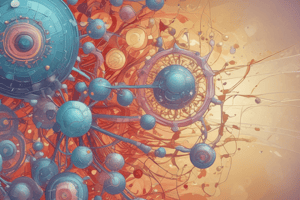Podcast
Questions and Answers
What primarily triggers the innate immune system?
What primarily triggers the innate immune system?
- Increased white blood cell count
- T-cell activation
- Presence of antibodies
- Exposure to pathogens (correct)
Which types of cells are considered inflammatory cells in the innate immune response?
Which types of cells are considered inflammatory cells in the innate immune response?
- B cells and plasma cells
- Neutrophils and erythrocytes
- Natural killer cells and T-helper cells
- Mast cells, macrophages, and dendritic cells (correct)
What are DAMPs in the context of innate immunity?
What are DAMPs in the context of innate immunity?
- Damage-associated molecular patterns (correct)
- Dilated airway muscle proteins
- Defensive antibodies in serum
- Antigen-presenting complexes
What role do PAMPs play in the innate immune response?
What role do PAMPs play in the innate immune response?
Which statement reflects a common misconception about the innate immune system?
Which statement reflects a common misconception about the innate immune system?
What type of immune system is directly triggered by pathogen exposure?
What type of immune system is directly triggered by pathogen exposure?
Which cells are commonly involved in the inflammatory response of innate immunity?
Which cells are commonly involved in the inflammatory response of innate immunity?
What triggers the release of DAMPs in the context of innate immunity?
What triggers the release of DAMPs in the context of innate immunity?
Which of the following correctly describes the role of PAMPs in the innate immune system?
Which of the following correctly describes the role of PAMPs in the innate immune system?
What constitutes the primary initial response of the immune system to cellular damage?
What constitutes the primary initial response of the immune system to cellular damage?
What is one common trigger that activates the innate immune system?
What is one common trigger that activates the innate immune system?
Which cells are specifically mentioned as inflammatory cells involved in the innate immune response?
Which cells are specifically mentioned as inflammatory cells involved in the innate immune response?
What does DAMPs stand for in relation to innate immunity?
What does DAMPs stand for in relation to innate immunity?
Which of the following is a function of the innate immune system?
Which of the following is a function of the innate immune system?
Which statement best describes PAMPs in the context of the innate immune system?
Which statement best describes PAMPs in the context of the innate immune system?
Flashcards
Innate Immunity
Innate Immunity
The body's first line of defense against pathogens, injury, or cellular damage. It acts rapidly and non-specifically.
Damage-associated molecular patterns (DAMPs)
Damage-associated molecular patterns (DAMPs)
Molecules released by damaged cells that signal the innate immune system, alerting it to danger.
Pattern Recognition
Pattern Recognition
The process by which the innate immune system recognizes and responds to pathogens.
Pathogen-associated molecular patterns (PAMPs)
Pathogen-associated molecular patterns (PAMPs)
Signup and view all the flashcards
Innate Immune Cells
Innate Immune Cells
Signup and view all the flashcards
Pattern Recognition (Innate Immunity)
Pattern Recognition (Innate Immunity)
Signup and view all the flashcards
What is innate immunity?
What is innate immunity?
Signup and view all the flashcards
What are PAMPs?
What are PAMPs?
Signup and view all the flashcards
What role do innate immune cells play?
What role do innate immune cells play?
Signup and view all the flashcards
What is the process of inflammation?
What is the process of inflammation?
Signup and view all the flashcards
How does the innate immune system fight off threats?
How does the innate immune system fight off threats?
Signup and view all the flashcards
Study Notes
Innate Immunity
- Cause: Exposure to pathogens, injury, or cellular damage triggers the innate immune system. Common triggers include microbial antigens and damage-associated molecular patterns (DAMPs).
- Pathophysiology:
- Recognition of Threats: Pattern recognition receptors (PRRs) recognize pathogen-associated molecular patterns (PAMPs) on microbes.
- Inflammatory Cells: Inflammatory cells (mast cells, macrophages, dendritic cells) become activated.
- Cytokine and Chemokine Release: Activated cells release cytokines (TNF-α, IL-1, IL-6) and chemokines, recruiting other immune cells to the infection site. Mast cells release histamine, leading to vasodilation and increased vascular permeability.
- Immune Cell Recruitment: Neutrophils and macrophages are recruited to engulf pathogens via phagocytosis. Natural killer (NK) cells destroy virus-infected cells and tumor cells.
- Systemic Manifestations: Cytokine release causes fever and triggers the acute-phase response (increased CRP and fibrinogen production). This response aids in containing and eliminating infections, and promotes tissue repair.
- Transmission: Not transmissible. Innate immunity is a natural defense mechanism present at birth.
- Risk Factors: Age (newborns and elderly), chronic illnesses (diabetes, cardiovascular disease, cancer), immunosuppression (chemotherapy or immunosuppressive medications), lifestyle factors (smoking, poor diet, inactivity), and genetic disorders (primary immunodeficiencies like SCID).
Adaptive Immunity
- Cause: Exposure to specific antigens (viral, bacterial, or parasitic) through infection or vaccination.
- Pathophysiology:
- Antigen Recognition: Antigen-presenting cells (APCs) like dendritic cells and macrophages present antigens to T-helper (Th) cells via MHC class II molecules.
- Antibody Production: B cells differentiate into plasma cells releasing antibodies. Memory B cells remain for future responses.
- Cell-Mediated Immunity: Cytotoxic T cells (CD8+ T cells) kill virus-infected cells. Memory T cells enable a quicker response.
- Transmission: Not transmissible. Adaptive immunity is not inheritable.
- Risk Factors:
- Chronic Illnesses: Conditions like diabetes, cardiovascular disease, and cancer can reduce innate immune response efficiency.
- Immunosuppression: Chemotherapy or immunosuppressive medications weaken the innate immune response.
- Lifestyle Factors: Smoking, poor diet, and inactivity are linked to chronic inflammation, which can dysregulate innate immunity.
- Age: Elderly individuals experience reduced T cell and B cell function.
- HIV/AIDS: Targets CD4+ T cells, impairing adaptive immunity.
- Autoimmune Disorders: Can cause the immune system to attack itself.
- Vaccination Status: Lack of vaccination may result in a lack of immune memory.
- Immunosuppressive Therapy: Chemotherapy/corticosteroids impair adaptive immunity.
- Genetic Disorders: Primary immunodeficiencies like SCID impair B and T cells function.
- Age (elderly): reduced T-cell and B-cell function in elderly individuals affects both innate and adaptive immunity.
- HIV/AIDS: Impacts CD4+ T cells, affecting both innate and adaptive immunity.
- Autoimmune disorders: Immune system attacks healthy tissues, impacting both innate and adaptive immunity
- Vaccination Status: Lack of vaccination reduces immune memory impacting both innate and adaptive immunity.
- Immunosuppressive Therapy: Chemotherapy/corticosteroids impair both innate and adaptive immunity.
- Genetic Disorders: Primary immunodeficiencies like SCID impair both innate and adaptive immunity.
Studying That Suits You
Use AI to generate personalized quizzes and flashcards to suit your learning preferences.




